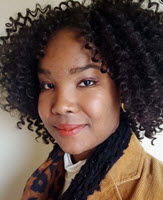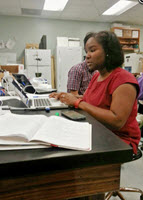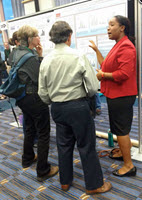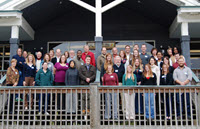
Nikaela Flournoy’s scientific journey has always carried a societal tie, from her passion for research’s social relevance to her realizations about the relationship between society and STEM (science, technology, engineering, and math). Though she is excited to see a greater emphasis on STEM in primary and secondary education, she hopes to help expand STEM awareness and curriculum to students from diverse educational and social backgrounds.
Nikaela recently completed her doctoral studies in the University of Alabama’s Department of Biological Sciences and was honored as a GoMRI Scholar with the Alabama Center for Ecological Resilience (ACER). She continues her ACER research as a post-doctoral researcher at the University of Alabama.
Her Path

Nikaela learned about the possibilities of scientific research as an undergraduate student at Alabama A&M University. Her high school curriculum included standard science courses but they did not highlight the diverse opportunities a scientific career could hold. “I knew scientific research existed before I attended Alabama A&M, but I didn’t know the scope of it until I was offered the opportunity to work in a research lab,” said Nikaela. She worked as an undergraduate research assistant while completing her biology degree and completed a master’s degree in microbiology at the University of Iowa with a focus on virology.
Nikaela’s educational background provided her with different perspectives in the sciences. While her biology research fostered an interest in environmental microbiology, her virology research generated an awareness about public health and the societal relevance of scientific research. When the 2010 Deepwater Horizon oil spill occurred, Nikaela was still unsure if she wanted to continue her scientific education through a doctoral program. However, the images of the oil as it entered the coastal environment and the expectation of downstream economic impacts inspired her to search for research opportunities where she could use her skillsets for the greater good. “Seeing the graphic imagery within the northern Gulf of Mexico inspired me to pursue research that would utilize my prior skillsets to investigate the interface between the environment and public health,” she said. In 2011, she joined Dr. Patricia Sobecky’s research investigating the long-term effects of Deepwater Horizon on the Alabama coastline, a collaboration with Dr. Behzad Mortazavi’s nitrogen cycling lab at the Dauphin Island Sea Lab (DISL). Their work became part of the ACER project in 2015.
Her Work

Coastal saltmarshes help remove anthropogenic nitrogen from the coastal ecosystem through processes such as denitrification, a microbial process that reduces nitrate in saltmarsh sediments by releasing it into the atmosphere as nitrogen gas. Large-scale contamination events such as oil spills can potentially cause losses in saltmarsh vegetation, impairing the marsh’s ability to remove nitrogen. Nikaela analyzes DNA in samples from Deepwater Horizon-impacted subtidal and vegetated saltmarshes to understand resident microbes’ presumed contributions to nitrogen removal and its effects on microbial diversity.
Nikaela extracts DNA from sediment samples collected from the Chandeleur Islands five years after it was heavily oiled during Deepwater Horizon and analyzes it using next-generation Illumina sequencing. She applies bioinformatic approaches to determine which bacteria are present and assesses their genetic potential to remove nitrogen. She then compares and contrasts those metrics between saltmarsh conditions to observe how loss of vegetation might impact the marsh’s denitrification potential. So far, Nikaela and her collaborators observed that the average denitrification capacity of vegetated marshes was four-times higher than unvegetated marshes. Denitrifying microbes were equally abundant in both types of marsh, suggesting that vegetation regulates the denitrifiers’ activity rather than their abundance.
Her Learning

Nikaela’s experiences working with Dr. Sobecky have provided her opportunities to experience many aspects of microbial ecology as it relates to innovation, engagement, and advocacy efforts for women in STEM. She believes that her sharpened drive is a reflection of Sobecky’s own enthusiasm and passion for their research. “Dr. Sobecky always emphasizes the importance of reading older literature, as it contains much of the foundational theory that most metagenomic principles are based on today,” Nikaela said. “She is a consistent source of resources, mentorship, and encouragement, which are critical traits for a graduate advisor. It’s important that young scientists like myself have mentors like Dr. Sobecky who encourage us to be resilient in our research pursuits.”
One of Nikaela’s most memorable moments during her Ph.D. experience was attending the Women of Color STEM Entrepreneurship Conference hosted by the National STEM Collaborative, a consortium focused on supporting minority girls and women in STEM. Sobecky’s involvement with the Collaborative connected Nikaela with the conference and offered her a unique experience that she believes she couldn’t have found anywhere else. “Never before had I been around so many minority women with advanced STEM degrees and careers in one space,” she said. “The outpouring of encouragement from women in all aspects of STEM was amazing.”
Her Future
Nikaela currently works as a post-doctoral researcher in Sobecky’s lab and hopes to eventually work in an administrative position at a historically black college or university (HBCU) and give back to the community that introduced her to research. “I got my start at an HBCU. I feel like it’s my responsibility as a research scientist and educator to teach at an HBCU and provide the next-generation of research scientists with the same opportunities that I had and more,” she said.
Praise for Nikaela
Sobecky described Nikaela as a scientist who shows the strength, perseverance, and work ethic that advisors always hope to see develop in the students and postdocs they mentor. She praised Nikaela for always seeking to learn and bring new knowledge to her research projects. Nikaela’s drive to share science with others and invest in other upcoming scientists particularly stood out to Sobecky, who said “She is dedicated to paying it forward and helping others learn more about STEM and to helping them develop professionally. Nikaela embodies the consummate scientist and science educator that our nation needs to help solve societal issues.”
The GoMRI community embraces bright and dedicated students like Nikaela Flournoy and their important contributions. The GoMRI Scholars Program recognizes graduate students whose work focuses on GoMRI-funded projects and builds community for the next generation of ocean science professionals. Visit the ACER website to learn more about their work.
************
The Gulf of Mexico Research Initiative (GoMRI) is a 10-year independent research program established to study the effect, and the potential associated impact, of hydrocarbon releases on the environment and public health, as well as to develop improved spill mitigation, oil detection, characterization and remediation technologies. An independent and academic 20-member Research Board makes the funding and research direction decisions to ensure the intellectual quality, effectiveness and academic independence of the GoMRI research. All research data, findings and publications will be made publicly available. The program was established through a $500 million financial commitment from BP. For more information, visit https://gulfresearchinitiative.org/.
© Copyright 2010-2018 Gulf of Mexico Research Initiative (GoMRI) – All Rights Reserved. Redistribution is encouraged with acknowledgement to the Gulf of Mexico Research Initiative (GoMRI). Please credit images and/or videos as done in each article. Questions? Contact web-content editor Nilde “Maggie” Dannreuther, Northern Gulf Institute, Mississippi State University (maggied@ngi.msstate.edu).
